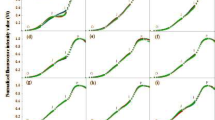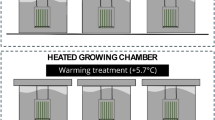Abstract
Previous studies have shown that in water the affinity of submerged macrophytes for CO2 is higher for species restricted to CO2 than for species with an additional ability to use bicarbonate. We measured slopes of CO2 uptake versus CO2 concentration in the gas phase in air, nitrogen and helium for pairs of species, having or lacking the ability to use bicarbonate, but with similar leaf morphology. For species restricted to CO2, the slope in nitrogen and helium was 1.5 times and 3.2 times greater than in air. The increased slope in nitrogen results from a suppression of photorespiration. The further increase in helium reflects the increased rate of diffusion of CO2 and shows that, even in gas, external diffusion through the boundary layer is a significant hindrance to CO2 uptake. In contrast, in species able to use bicarbonate, the uptake slope was not affected by gas composition, suggesting that photorespiration is absent or photorespired CO2 is efficiently trapped and that internal resistance is high relative to external resistance. Elodea canadensis specimens grown under high concentrations of CO2 de-regulated their ability to use bicarbonate, and slopes of CO2 uptake in helium were significantly greater than in air or nitrogen. Overall, these results are consistent with the notion that while a high affinity for CO2 will maximise carbon uptake in species restricted to CO2, for species able to use bicarbonate, a high internal resistance would reduce loss of CO2 and help maintain high concentrations of CO2 at the site of fixation.
Similar content being viewed by others
References
Beer S (1989) Photosynthesis and photorespiration of marine angiosperms. Aquat Bot 34: 153–166
Black MA, Maberly SC and Spence DHN (1981) Resistances to carbon dioxide fixation in four submerged freshwater macrophytes. New Phytol 89: 557–568
Brechignac F and Lucas WJ (1987) Photorespiration and internal CO2 accumulation in Chara corallina as inferred from the influence of DIC and O2 on photosynthesis. Plant Physiol 83: 163–169
Gimmler H, Weiss C, Baier M and Hartung W (1990) The conductance of the plasmalemma for CO2. J Exp Bot 41(228): 785–795
Lawlor DW (1993) Photosynthesis: Molecular, Physiological and Environmental Processes. Longman Scientific & Technical, New York
Lloyd NDH, Canvin DT and Bristow JM (1977) Photosynthesis and photorespiration in submerged aquatic vascular plants. Can J Bot 55: 3001–3005
Lucas WJ (1983) Photosynthetic assimilation of exogenous HCO3¯ by aquatic plants. Annu Rev Plant Physiol 34: 71–104
Maberly SC and Madsen TV (1998) Affinity for CO2 in relation to the ability of freshwater macrophytes to use HCO3¯. Funct Ecol 12: 99–106
Maberly SC and Spence DHN (1983) Photosynthetic inorganic carbon use by freshwater plants. J Ecol 71: 705–724
Madsen TV (1984) Resistance to CO2 fixation in the submerged aquatic macrophyte Callitriche stagnalis Scop. J Exp Bot 35: 338–347
Madsen TV and Maberly SC (1991) Diurnal variation in light and carbon limitation of photosynthesis by two species of submerged freshwater macrophyte with a differential ability to use bicarbonate. Freshwater Biol 26: 175–187
Madsen TV, Maberly SC and Bowes G (1996) Photosynthetic acclimation of submersed angiosperms to CO2 and HCO3¯. Aquat Bot 53: 15–30
Mason EA and Marrero TR (1970) The diffusion of atoms and molecules. Adv Atomic Mol Phys 6: 155–232
Mott KA and Parkhurst DF (1991) Stomatal responses to humidity in air and helox. Plant Cell Environ 14: 509–515
Parkhurst DF and Mott KA (1990) Intercellular diffusion limits to CO2 uptake in leaves. Plant Physiol 94: 1024–1032
Prins HBA and Elzenga JTM (1989) Bicarbonate utilization: Function and mechanism. Aquat Bot 34: 59–83
Prins HBA and Wolff RW (1974) Photorespiration in leaves of Vallisneria spiralis. The effect of oxygen on the carbon dioxide compensation point. P K Ned Akad C Biol 77: 239–245
Raven JA (1984) Energetics and Transport in Aquatic Plants. Alan R. Liss, New York
Reiskind JB, Beer S and Bowes G (1989) Photosynthesis, photorespiration and ecophysiological interactions in marine macroalgae. Aquat Bot 34: 131–152
Reiskind J, Madsen TV, van Ginkel LC and Bowes G (1997) Evidence that inducible C4-type photosynthesis is a chloroplastic CO2-concentrating mechanism in Hydrilla, a submerged monocot. Plant Cell Environ 20: 211–220
Simpson PS, Eaton JW and Hardwick K (1980) The influence of environmental factors on apparent photosynthesis and respiration of the submersed macrophyte Elodea canadensis. Plant Cell Environ 3: 415–423
Smart RM and Barko JW (1985) Laboratory culture of submersed freshwater macrophytes on natural sediments. Aquat Bot 21: 251–263
Spence DHN and Maberly SC (1985) Occurrence and ecological importance of HCO3¯use among aquatic higher plants. In: Lucas WJ and Berry JA (eds) Inorganic Carbon Uptake by Aquatic Photosynthetic Organisms, pp 125–143. The American Society of Plant Physiologists, Rockville, Maryland
Søndergaard M (1979) Light and dark respiration and the effect of the lacunal system on refixation of CO2 in submerged aquatic plants. Aquat Bot 6: 269–283
Søndergaard M and Wetzel RG (1980) Photorespiration and internal recycling of CO2 in the submerged angiosperm Scirpus subterminalis. Can J Bot 6: 591–598
Van TK, Haller WT and Bowes G (1976) Comparison of the photosynthetic characteristics of three submerged aquatic plants. Plant Physiol 58: 761–768
Author information
Authors and Affiliations
Corresponding author
Rights and permissions
About this article
Cite this article
Madsen, T.V., Maberly, S.C. High internal resistance to CO2 uptake by submerged macrophytes that use HCO3 −: measurements in air, nitrogen and helium. Photosynthesis Research 77, 183–190 (2003). https://doi.org/10.1023/A:1025813515956
Issue Date:
DOI: https://doi.org/10.1023/A:1025813515956




